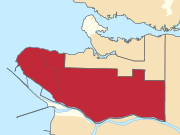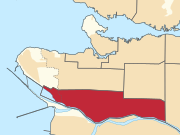Federal electoral district in British Columbia, Canada
Vancouver South (French: Vancouver-Sud) is a federal electoral district in British Columbia, Canada, that has been represented in the House of Commons of Canada from 1917 to 1997, and since 2004. It covers the southern portion of the city of Vancouver, British Columbia.
Demographics
The riding is one of the most diverse in Canada, with less than one-fifth of the population being of European descent.[2][3] As of 2021, four pan-ethnic groups form greater than 10 percent of the riding; 38.1% East Asian, 18.7% European, 17.8% South Asian and 16% Southeast Asian.
Vancouver South is the centre of the city's South Asian community; the colourful Punjabi Market (Little India) and the close-knit community of religious Sikhs dominate the area.[4] The service sector, retail trade and manufacturing are the major sources of employment in Vancouver South. Nearly 30% of residents over the age of 25 years have obtained a university certificate or degree. The average family income is over $71,000. Unemployment is around 6.3%.[5]
- ^ Statistic includes total responses of "Chinese", "Korean", and "Japanese" under visible minority section on census.
- ^ Statistic includes all persons that did not make up part of a visible minority or an indigenous identity.
- ^ Statistic includes total responses of "Filipino" and "Southeast Asian" under visible minority section on census.
- ^ Statistic includes total responses of "West Asian" and "Arab" under visible minority section on census.
- ^ Statistic includes total responses of "Visible minority, n.i.e." and "Multiple visible minorities" under visible minority section on census.
History
This electoral district was formed in 1914 from Vancouver City riding.
In 1996, it was abolished and used to create Vancouver South—Burnaby with portions of New Westminster—Burnaby.
Vancouver South was re-created in 2003 when the Burnaby sections were moved into the new ridings Burnaby—Douglas and Burnaby—New Westminster.
The 2012 federal electoral boundaries redistribution concluded that the electoral boundaries of Vancouver South should be adjusted, and a modified electoral district of the same name will be contested in future elections.[11] The redefined Vancouver South loses a portion of its current territory west of Cambie Street to the new district of Vancouver Granville, and gains a small area in the northeast currently included in Vancouver Kingsway. These new boundaries were legally defined in the 2013 representation order, which came into effect upon the call of the 42nd Canadian federal election, scheduled for October 2015.[12]
Historical boundaries
1914 representation order
1933 representation order
1947 representation order
1952 representation order
1966 representation order
1976 representation order
1987 representation order
1996 representation order (as Vancouver South—Burnaby)
2003 representation order
2013 representation order
2023 representation order (as Vancouver Fraserview—South Burnaby)
Members of Parliament
This riding has elected the following members of Parliament:
Election results
Vancouver South, 2004–present
Its current representing MP is Harjit Sajjan, who is Minister of International Development in the current federal Cabinet. He has been its MP since the 2015 federal election, when he beat the Conservative then-incumbent by more than 6,000 votes.
Graph of election results in Vancouver South (since 2004, minor parties that never got 2% of the vote or didn't run consistently are omitted)
Vancouver South, 1917–1997
Graph of election results in Vancouver South (1917-1993, minor parties that never got 2% of the vote or didn't run consistently are omitted)
See also
References
- "Vancouver South (federal electoral district) (Code 59034) Census Profile". 2011 census. Government of Canada - Statistics Canada. Retrieved March 6, 2011.
Notes
- ^ a b "Population and dwelling counts: Canada and federal electoral districts (2013 Representation Order)". Statistics Canada. Government of Canada. February 9, 2022. Retrieved February 9, 2022.
- ^ The growing diversity within federal ridings. Policy Options. Retrieved on 2018-19-10.
- ^ "Economy trumps all in culturally diverse Vancouver South". The Globe And Mail. March 30, 2011.
- ^ Conservative Wai Young beats Dosanjh in rematch. The Globe and Mail. Retrieved on 2014-04-12.
- ^ Vancouver South, CBC.ca, 2008.
- ^ Government of Canada, Statistics Canada (October 26, 2022). "Census Profile, 2021 Census of Population Vancouver South British Columbia [Federal electoral district (2013 Representation Order)". www12.statcan.gc.ca. Retrieved November 17, 2022.
- ^ Government of Canada, Statistics Canada (October 27, 2021). "Census Profile, 2016 Census Vancouver South [Federal electoral district], British Columbia and British Columbia [Province]". www12.statcan.gc.ca. Retrieved November 17, 2022.
- ^ Government of Canada, Statistics Canada (November 27, 2015). "NHS Profile, Vancouver South, British Columbia, 2011". www12.statcan.gc.ca. Retrieved February 17, 2023.
- ^ Government of Canada, Statistics Canada (August 20, 2019). "Federal Electoral District Profile of Vancouver South, British Columbia (2003 Representation Order), 2006 Census". www12.statcan.gc.ca. Retrieved November 17, 2022.
- ^ Government of Canada, Statistics Canada (July 2, 2019). "2Federal Electoral District Profile of Vancouver South - Vancouver-Sud, British Columbia (2003 Representation Order), 2001 Census". www12.statcan.gc.ca. Retrieved November 6, 2022.
- ^ Final Report – British Columbia
- ^ Timeline for the Redistribution of Federal Electoral Districts
- ^ "Confirmed candidates — Vancouver South". Elections Canada. September 1, 2021. Retrieved September 6, 2021.
- ^ "List of confirmed candidates". Elections Canada. Retrieved October 4, 2019.
- ^ "Election Night Results". Elections Canada. Retrieved November 15, 2019.
- ^ Elections Canada – Confirmed candidates for Vancouver South, 30 September 2015
- ^ Elections Canada – Preliminary Election Expenses Limits for Candidates
- ^ Pundits' Guide to Canadian Elections
External links
- Library of Parliament Riding Profile 1914-1996
- Library of Parliament Riding Profile 1996-present
- Expenditures - 2004
- Website of the Parliament of Canada
49°13′N 123°04′W / 49.22°N 123.07°W / 49.22; -123.07











